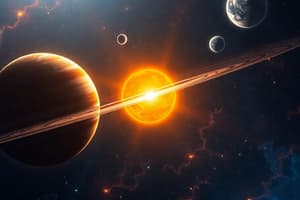Podcast
Questions and Answers
Mercury is the only planet without moons.
Mercury is the only planet without moons.
True (A)
Earth is the only planet in our solar system with life.
Earth is the only planet in our solar system with life.
True (A)
The amount of moons that Saturn has is $53 + 2$.
The amount of moons that Saturn has is $53 + 2$.
False (B)
The Sun is in the center of the solar system, and the planets orbit it.
The Sun is in the center of the solar system, and the planets orbit it.
Earth takes 12 months to orbit the Sun, while the Moon takes less than 28 days to travel around the Earth.
Earth takes 12 months to orbit the Sun, while the Moon takes less than 28 days to travel around the Earth.
Jupiter is $318$ times bigger than Earth.
Jupiter is $318$ times bigger than Earth.
Neptune is the fourth largest planet in the solar system.
Neptune is the fourth largest planet in the solar system.
Saturn has the most documented moons of any planet.
Saturn has the most documented moons of any planet.
Venus is the only planet with dangerous clouds.
Venus is the only planet with dangerous clouds.
Flashcards
Mercury
Mercury
The smallest planet and nearest to the Sun.
Earth
Earth
The only planet known to support life, with one moon.
Mars
Mars
A small, rocky planet known for its red color and two moons.
Saturn
Saturn
Signup and view all the flashcards
Jupiter
Jupiter
Signup and view all the flashcards
Neptune
Neptune
Signup and view all the flashcards
Venus
Venus
Signup and view all the flashcards
Planetary Orbits
Planetary Orbits
Signup and view all the flashcards
Dwarf Planet
Dwarf Planet
Signup and view all the flashcards
Study Notes
Planets in Our Solar System
- Mercury: Smallest planet, closest to the Sun, grey and rocky, no moons.
- Earth: Rocky, supports life, light blue with white clouds, one moon.
- Mars: Red-orange, rocky, lifeless, two moons (Phobos and Deimos).
- Saturn: Pale yellow, famous for rings, one of the most beautiful, 53 known moons.
- Jupiter: 318 times bigger than Earth, one of the eight main planets.
- Neptune: Fourth largest planet, strong winds (2000 km/hour).
- Venus: Poisonous yellow clouds.
- Pluto: Former planet, now considered a dwarf planet.
- Dwarf Planets: Three other dwarf planets orbit the Sun.
- Orbits: Planets orbit the Sun, Earth takes 12 months to orbit.
- Moons: Earth, Mars, Saturn have moons. Luna (Earth's Moon) takes less than 28 days to orbit Earth.
Studying That Suits You
Use AI to generate personalized quizzes and flashcards to suit your learning preferences.




